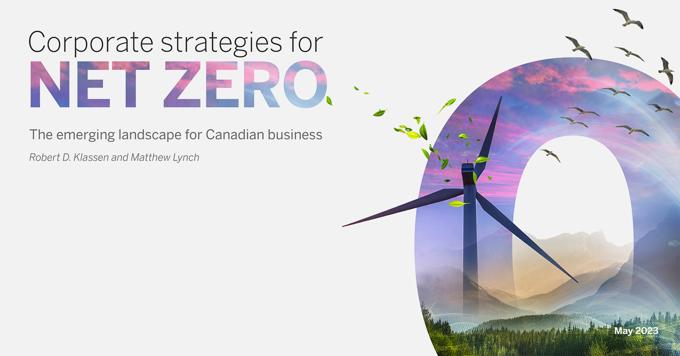For many Canadian companies, the push for net zero is no longer a distant goal – it’s a defining business challenge.
With 2030 mid-course targets looming and climate disclosure requirements tightening, firms are feeling the pressure to turn ambition into action. But the path forward remains complex.
That’s where the Ivey Centre for Building Sustainable Value (BSV) is stepping in. In a new report, Corporate strategies for net zero – aligning commitments and capabilities to drive the climate transition, authors Matthew Lynch (Staff Director, BSV), Robert D. Klassen (Associate Dean, Research and Ivey Professor of Operations Management), and HBA Sustainability Certificate student Rebecca Zuker offer Canadian firms clear thinking and practical strategies for navigating the net-zero transition – drawing on insights from over 30 executives across 10 key sectors already leading the way.
Building on Ivey’s original net-zero research, this new report moves beyond theory – outlining three interconnected pillars that can help businesses accelerate climate progress, lower costs, and unlock new growth opportunities amid a multifaceted and polarizing atmosphere.
There’s no single playbook
As pressure mounts to act on climate, firms across the nation are searching for a clear roadmap. But as Lynch points out, there is no single playbook.
“One thing that became clear through our interviews with executives is that there’s no “one size fits all” answer,” he said. “Success depends on each firm’s unique objectives, current position, and capabilities. And then navigating the tensions between them.”
Yet within those tensions lie opportunities. As executives shared, it was often in the most challenging moments of their net zero journey that new ideas emerged – innovations that could shape their strategies for years to come.
“While many firms struggled at first, we’re now seeing a mindset shift,” Lynch said. “Leaders are beginning to recognize that net zero isn’t just an ethical imperative, but a strategic one, with real potential for value creation.”
One of the clearest areas of value? Stakeholder trust. Investors, customers, and regulators increasingly expect not just climate goals, but credible, actionable plans that show how firms will manage risk and build resilience through the transition.
Building credible plans is where many companies are getting stuck. But others are already forging ahead, and their experience has helped shape three practical pillars to guide Canadian firms of all sizes through similar challenges and accelerate their progress.
Three pillars for leading the net-zero shift
Acknowledging the unique complexities and challenges that each unique firm faces, from their interviews, authors have identified three dimensions that are foundational to a firm as it charts its transition.
1. Vision & commitments
The first step, the authors note, is clarity – defining a net-zero vision and understanding who’s driving it. In some firms, senior executives lead the charge; in others, pressure comes from investors, customers, or employees.
“No matter who initiates it, no one drives net zero alone,” said Klassen. “Lasting progress depends on broad, ongoing support.”
Next comes the delicate balance between ambition and action. Bold goals can inspire, but without a plan, they fall flat or risk accusations of greenwashing. Modest targets may be more achievable but risk limiting innovation, disappointing investors and customers.
To strike that balance, many firms are adopting science-based targets, like those from SBTi – the gold standard for ensuring corporate climate goals are not just ambitious but aligned with what science says is necessary.
2. Strategic positioning
Net-zero commitments are reshaping business strategy, framing both risks and opportunities. While startups can build from a blank slate, established firms must strike a balance between current operations and future ambition. Some must make only small tweaks; others need to rethink their entire business model.
“We see firms taking many different paths,” said Klassen. “But the real innovation happens when net-zero goals are embedded in core strategy – not sidelined as extra projects.”
One of the biggest areas for innovation lies in Scope 3 emissions: the indirect emissions across a company’s value chain.
“Scope 3 is difficult,” Klassen explained. “It not only covers suppliers, but also how products are used or consumed, which is hard to track. But it’s also where companies can potentially make the biggest impact.”
Already, leading firms are finding strategic advantages in helping customers reduce these emissions through tools like carbon calculators, renewable energy sourcing, or built-in energy-saving solutions. These efforts not only cut emissions but also open new markets and revenue streams.
Ultimately, integrating net-zero goals requires a hard look at how well a company’s core strategy aligns with reducing emissions across all parts of the value chain – and how that alignment will evolve over the next two decades.
3. Critical Capabilities
Historically, climate initiatives were siloed in sustainability departments, which focused on gradual improvements and voluntary reporting. But today’s net-zero goals demand deeper transformation across an organization.
"It’s no longer enough to have a sustainability team working in isolation,” said Lynch. “Climate strategy must be embedded across the entire organization. That means building real capabilities: the systems, skills, and structures that allow every part of the business to drive meaningful, measurable change."
To make that change, firms must build two kinds of capabilities:
1. Innovation and organizational change
Embedding climate strategy into business requires building internal core capabilities, including:
- Improving emissions tracking – especially Scope 3
- Redesigning products and processes
- Acquiring new capabilities through innovation or acquisition
- Aligning internal structures, investments, and decision-making with climate goals
- Using scenario analysis to plan for uncertain futures
2. Partnerships
Understanding that collaboration is essential to successful decarbonization, leading firms are:
- Working closely with suppliers and customers to reduce emissions
- Joining sector-wide or multi-sector alliances to tackle shared challenges
- Exploring new business models and markets tied to climate performance
Building resilience for what’s next
Pursuing bold climate action is no easy feat. It’s complex, demanding, and filled with uncertainty and scrutiny. But as the authors emphasize, waiting for true clarity is the riskiest move of all.
“No one has the perfect net-zero plan figured out – and they likely won’t,” said Lynch. “But waiting for certainty is riskier than acting with what you know today.”
To make meaningful progress, Canadian business leaders must commit credibly, plan strategically, and invest in the innovation and partnerships that will position their firms to thrive in an increasingly climate-shaped economy.
“There’s no denying it – climate change will continue to reshape business,” said Klassen. “But by applying these three pillars, and learning from those already leading the way, companies can move forward with greater confidence and long-term resilience.”
Ready to turn net-zero ambition into firm-level action? Read the full report from Ivey’s Centre for Building Sustainable Value: Corporate strategies for net zero – Aligning commitments and capabilities to drive the climate transition.












